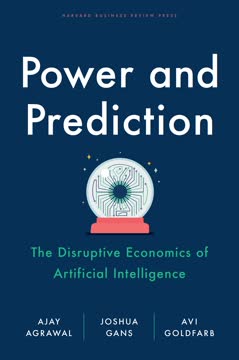Key Takeaways
1. AI's Enterprise Embrace: A Slow but Steady Revolution
I certainly agree that some of this excitement is warranted.
Cautious optimism. While AI hype abounds, a measured approach is crucial. The technology holds immense potential, but its integration into enterprises is an evolutionary process, not a sudden revolution. Early adopters faced challenges, highlighting the need for realistic expectations and strategic alignment.
Enterprise enthusiasm. Despite the measured pace, enterprise managers express strong optimism about AI's potential. Surveys reveal that a significant majority believe cognitive technologies are vital for both internal processes and product offerings. This enthusiasm underscores the growing recognition of AI's transformative power.
Early stages of adoption. Despite the enthusiasm, AI adoption is still in its early stages. Many organizations are experimenting with the technology but haven't yet fully integrated it into their core operations. This suggests a need for continued exploration, strategic planning, and a focus on practical applications.
2. Cognitive Technologies: A Trio of Business Capabilities
Broadly speaking, AI or cognitive technologies employ such capabilities—previously possessed only by humans—as knowledge, insight, and perception to solve narrowly defined (with the current state of technology) tasks.
Three core capabilities. AI's impact on business can be categorized into three key areas:
- Automating structured and repetitive work processes
- Gaining insight through extensive analysis of structured data
- Engaging with customers and employees using natural language processing
Technology diversity. These capabilities are enabled by a range of underlying technologies, including machine learning, neural networks, natural language processing, and robotic process automation. Understanding these technologies and their specific applications is crucial for effective implementation.
Business-driven approach. Focusing on business capabilities rather than specific technologies allows organizations to align AI initiatives with strategic goals. This approach ensures that AI investments are directed toward solving real-world problems and creating tangible value.
3. Process Automation: Streamlining Repetitive Tasks
The automation of digital and physical tasks—most often back-office administrative and financial activities—was the most common activity we found.
RPA dominance. Process automation, particularly through robotic process automation (RPA), is the most prevalent application of AI in business today. RPA involves automating structured digital tasks, mimicking human interaction with information systems.
Benefits of RPA:
- Cost-effectiveness
- Ease of implementation
- Quick return on investment
Beyond cost savings. While RPA can lead to staff reductions, its primary value lies in improving efficiency, reducing errors, and freeing up human workers for more strategic activities. This shift enables organizations to optimize processes and enhance overall performance.
4. Cognitive Insight: Unveiling Patterns in Vast Data
Applications that use algorithms to detect patterns in vast volumes of structured data and interpret its meaning—think of it as “analytics on steroids”—are the second broad AI category in business.
Analytics on steroids. Cognitive insight leverages machine learning algorithms to identify patterns and extract meaning from large datasets. This capability enables organizations to make more informed decisions, predict future outcomes, and optimize performance.
Applications of cognitive insight:
- Customer propensity modeling
- Fraud detection
- Predictive maintenance
- Personalized ad targeting
Data-driven decision making. Cognitive insight empowers organizations to move beyond traditional analytics and make data-driven decisions with greater precision and speed. This capability is particularly valuable in industries with vast amounts of data and complex decision-making processes.
5. Cognitive Engagement: Enhancing Interactions with Intelligence
These applications, the least common of the three, engage employees and customers by providing them with rich language or image-based personalized information and services.
Personalized experiences. Cognitive engagement focuses on enhancing interactions with customers and employees through personalized information and services. This category includes intelligent agents, chatbots, and recommendation systems.
Applications of cognitive engagement:
- 24/7 customer service
- Internal service sites for employees
- Product and service recommendation systems
- Health treatment recommendation systems
Human-machine collaboration. While cognitive engagement offers the potential for automated interactions, it's crucial to maintain a balance between automation and human touch. This ensures that customers and employees receive the support and guidance they need, while also leveraging the efficiency and scalability of AI.
6. Building a Cognitive Corporation: Key Capabilities
A key aspect of “what’s happening now” with AI in business is not only applications, but capabilities.
Beyond applications. Becoming a cognitive corporation requires more than just implementing AI applications. It involves building a set of core capabilities that enable organizations to effectively leverage AI across their operations.
Key capabilities:
- Understanding AI technologies and their applications
- Leveraging existing strengths in big data and analytics
- Creating a prioritized portfolio of AI projects
- Engaging in cognitive work redesign
- Focusing on scaling and achieving productivity benefits
Strategic alignment. Building these capabilities requires a strategic approach that aligns AI initiatives with business goals. This ensures that AI investments are directed toward creating sustainable competitive advantage.
7. Crafting a Cognitive Strategy: A Roadmap for Success
A strategy for AI/cognitive technologies can help to address this problem.
Strategic imperative. A well-defined cognitive strategy is essential for organizations seeking to maximize the value of their AI investments. This strategy should outline the organization's goals, priorities, and approach to AI implementation.
Key elements of a cognitive strategy:
- Defining objectives: What business problems will AI address?
- Identifying use cases: Where can AI create the most value?
- Assessing technology readiness: Is the technology up to the task?
- Developing a talent strategy: How will the organization acquire AI skills?
- Establishing a governance framework: How will AI be managed and controlled?
Proactive planning. By addressing these questions proactively, organizations can ensure that their AI initiatives are aligned with their strategic goals and that they are well-positioned to capitalize on the opportunities presented by cognitive technologies.
8. Navigating the Ethical Landscape of AI
The goal of this chapter was to introduce you to cognitive technology and to begin to address the overall context for its use by large organizations and vendors.
Ethical considerations. As AI becomes more prevalent, it's crucial to address the ethical implications of its use. This includes issues such as algorithmic bias, privacy, and the potential for job displacement.
Key ethical considerations:
- Ensuring fairness and transparency in AI algorithms
- Protecting privacy and data security
- Addressing the potential for job displacement
- Promoting responsible innovation
Proactive approach. Organizations should adopt a proactive approach to ethical considerations, establishing guidelines and frameworks to ensure that AI is used responsibly and ethically. This will help to build trust and ensure the long-term sustainability of AI initiatives.
9. The Future of Work: Augmentation over Automation
In the short run, AI will provide evolutionary benefits; in the long run, it is likely to be revolutionary.
Augmentation focus. While AI has the potential to automate many tasks, a more likely and desirable future involves augmentation, where humans and machines work together to enhance productivity and creativity. This approach leverages the strengths of both humans and AI, creating a more effective and fulfilling work environment.
Benefits of augmentation:
- Increased productivity and efficiency
- Enhanced creativity and innovation
- Improved job satisfaction
- Reduced risk of job displacement
Strategic advantage. By focusing on augmentation, organizations can create a more resilient and adaptable workforce, better positioned to thrive in the age of AI. This approach also fosters a culture of collaboration and innovation, driving long-term success.
10. Technology Choices: Build, Buy, or Blend?
The most aggressive users of artificial intelligence—both in their products and their internal processes—have been tech companies like Amazon .com.
Strategic technology decisions. Organizations face a range of technology choices when implementing AI, including whether to build their own solutions, buy them from vendors, or adopt a hybrid approach. The best approach depends on the organization's capabilities, resources, and strategic goals.
Factors to consider:
- Internal expertise: Does the organization have the skills to build AI solutions?
- Budget: How much can the organization invest in AI technology?
- Time to market: How quickly does the organization need to implement AI?
- Strategic control: How much control does the organization want over its AI technology?
Hybrid approach. A hybrid approach, combining open-source tools with proprietary solutions, can offer the best of both worlds. This allows organizations to leverage the flexibility and innovation of open-source while also benefiting from the support and expertise of vendors.
Last updated:
Review Summary
Readers found The AI Advantage to have a strong underlying message but criticized its lack of depth and reliance on widely-known examples. Some felt it offered practical insights for businesses considering AI implementation, while others found it outdated and repetitive. Positive reviews praised its accessibility and overview of AI's business applications. Criticisms included its focus on superficial AI technologies, consultant-like writing style, and limited exploration of more complex AI concepts. Overall, opinions were mixed, with readers seeking more in-depth analysis of AI's impact on work and industry.
Similar Books









Download PDF
Download EPUB
.epub digital book format is ideal for reading ebooks on phones, tablets, and e-readers.







